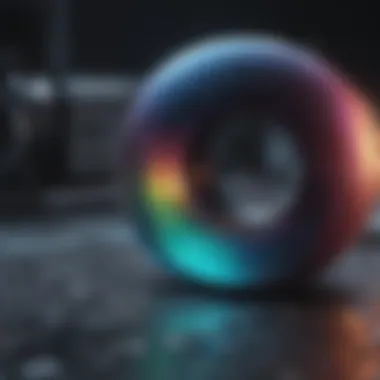Understanding Holographic Printing: In-Depth Insights


Background and Context
Holographic printing is a topic that combines art and science, capturing attention in both academia and industries. This technology uses light and its properties to create three-dimensional images. Understanding it requires delving into its underlying principles. The way light interacts with surfaces leads to unique visual effects that traditional printing cannot replicate.
Historically, holography dates back to the early 20th century but became a practical method only in the 1960s with the invention of the laser. Early applications were in scientific fields, contributing to advancements in optics. Over time, the commercial potential of holography was recognized, leading to its use in security features and artistic expression. The evolution of technology has pushed holographic printing into various industries, expanding its relevance.
Key Findings and Discussion
Research into holographic printing reveals several significant advantages over conventional methods. One of the most prominent benefits is the enhancement of security. Holograms are difficult to reproduce, making them ideal for protecting sensitive information and products. Industries like banking and pharmaceuticals have adopted holography to deter counterfeiting.
Another notable aspect is the aesthetic appeal of holographic prints. Products in the packaging sector utilize holography to attract customers. A well-designed holographic label can stand out on the shelf, increasing sales potential. The visual complexity of holograms invites curiosity and engagement from consumers.
Despite the advantages, challenges exist in the field of holographic printing. The cost of production can be higher than traditional methods, which may limit adoption for smaller businesses. Furthermore, technical expertise is required to develop effective holographic designs and implement printing techniques.
Innovation and Future Implications
Looking forward, the potential for innovation in holographic printing is immense. As technology progresses, costs may decrease, enhancing accessibility. Additionally, new applications are constantly emerging. For instance, the integration of augmented reality and holography presents exciting avenues for immersive experiences in marketing, entertainment, and education.
"The future of holographic printing lies in its versatility and ability to adapt to various sectors, enhancing security, aesthetics, and functionality."
In summary, holographic printing represents a convergence of technology and creativity. Its journey from a scientific novelty to a commercial powerhouse illustrates its significance. Professionals, researchers, and educators alike can glean insights into how holographic printing not only influences current practices but also shapes future possibilities.
For anyone interested in a deeper understanding of this field, further research is recommended, as developments continue to unfold rapidly. Share insights on forums like Reddit or engage with academic communities on platforms such as Facebook to discuss advancements and applications.
Foreword to Holographic Printing
Holographic printing represents a significant advancement in the field of visual technology. Its impact spans numerous industries, from packaging to art, promoting a depth of interaction seldom achieved by conventional printing techniques. This introduction aims to provide a brief overview of what holographic printing entails, setting the stage for a detailed exploration of its components and broader implications.
Understanding holographic printing is crucial. It not only involves complex scientific principles but also showcases innovative engineering that pushes the boundaries of how visual information is presented. The unique characteristics of holography, such as three-dimensional depth perception and the dynamic visual effects it creates, elevate it beyond traditional flat-image printing.
Definition and Concept
Holographic printing is a technique that captures and reproduces the light field of a scene, allowing viewers to perceive depth and dimension within an image. Unlike standard photos or prints, which present only flat representations, holograms are designed to exhibit a three-dimensional view. This happens through the interference of light reflecting off the recorded surface, allowing the eye to experience images much as they appear in real life.
The concept derives from the principle of holography, a method developed in the mid-20th century. To create a hologram, a laser is utilized to illuminate the subject. The light from the subject is then captured onto a photosensitive surface. When the hologram is illuminated with a coherent light source, the recorded light waves are reconstructed, presenting the three-dimensional image for viewing.
Historical Development
The history of holographic printing began in 1947, when physicist Dennis Gabor, working on electron microscopy, invented holography. Gabor's early experiments laid the groundwork for future research but did not achieve a practical application due to the limitations of available technology.
In the 1960s, the invention of the laser changed the landscape for holography. It provided the coherent light source necessary for producing clearer and more effective holograms. By the 1970s and 1980s, holography gained admires across various fields, particularly in data storage and security printing, as new techniques developed to create high-quality, reproducible images became available.
As technology advanced, particularly with digital printing systems, the application of holography expanded. The introduction of computer-generated holography in the 1990s further revolutionized the industry. Today, holographic printing is being used in a wide range of applications including packaging, security features on banknotes and cards, and artistic endeavors. The field continues to evolve, encouraging innovation and new methodologies.
"Holography combines art, science, and technology, stretching our perception of reality."
Through a better understanding of its principles and historical context, the relevance of holographic printing as a contemporary means of representation becomes clear. This technique not only sets itself apart from traditional methods but also promises future growth in various sectors.
The Science Behind Holography
The essence of holography lies in the merging of light and information. Understanding the science behind holography is crucial for grasping how this technology achieves its unique visual effects. Holography is based on intricate light interactions, which include interference and diffraction phenomena. These principles not only allow for the creation of three-dimensional images but also drive the advancements in holographic printing technologies.
To better comprehend the workings of holography, we will analyze its fundamental principles, particularly focusing on interference and diffraction. Additionally, we will look into various types of holograms, including transmission and reflection holograms, and their technical and practical implications.
Fundamental Principles
Interference


Interference is a core aspect of holography. It occurs when two or more light waves overlap and combine to form a new wave pattern. This phenomenon is responsible for the vivid images captured in holograms. The key characteristic of interference is its ability to produce patterns of light and dark that correspond to the original object's shape and texture.
For this article, interference is a beneficial choice because it enables the replication of depth and dimensionality in images. The unique feature of interference in holography is its capacity to create detailed images without the need for lensing systems. However, the downside is that interference patterns can be delicate and may require controlled environments for optimal visibility.
Diffraction
Diffraction contributes to how holograms scatter light. It refers to the bending of light waves around obstacles or through openings. This property plays a significant role in holography as it influences how the holographic images appear when viewed from different angles. The ability of diffraction to spread light is vital for creating the 3D effect associated with holograms.
The key characteristic of diffraction is its capacity to allow viewers to perceive images in multiple dimensions. This property makes it an essential consideration in holography, elevating it above traditional imaging techniques. However, a disadvantage of diffraction is that it may result in a loss of image clarity when viewed at extreme angles.
Types of Holograms
Understanding the different types of holograms is essential for recognizing their applications in various fields. Holograms can generally be classified into two main types: transmission and reflection holograms.
Transmission Holograms
Transmission holograms are designed to be viewed with laser light passing through them. This type of hologram captures an image by recording the light waves reflected from an object. The key characteristic of transmission holograms is that they provide a clear three-dimensional image when illuminated by coherent light.
In the context of this article, transmission holograms offer a beneficial choice for applications requiring precision and clarity, such as in scientific and medical fields. However, a unique feature is that they are less effective under white light, making them predominantly useful in controlled lighting environments.
Reflection Holograms
Contrastingly, reflection holograms are made to reflect light back to the observer. This type captures the light that bounces off an object. The key characteristic of reflection holograms is their versatility in being viewed under natural white light, which broadens their applicability, especially in consumer products.
In this article, reflection holograms offer significant value as they can be used in security features on identification documents and packaging. However, they may not provide the same level of detail and depth as transmission holograms, which can be a limitation in specific professional applications.
Understanding both interference and diffraction, along with the differences between transmission and reflection holograms, is fundamental for anyone engaging with holographic printing technology. It shapes how we apply these methods in real-world scenarios.
Holographic Printing Technologies
Holographic printing technologies are at the forefront of innovation within the field of optics and visual representation. These technologies enable the creation of three-dimensional images that have profound applications across numerous industries. Understanding these technologies is crucial as they offer unique advantages over traditional printing methods, not only enhancing visual appeal but also providing functional benefits such as improved security and durability. In this section, we will explore three prominent types of holographic printing technologies: laser-based holography, digital holography, and projected holography.
Laser-based Holography
Laser-based holography is one of the oldest and most established methods in holographic printing. This technique utilizes lasers to record light patterns reflected from an object. The core process involves shining a coherent light source, typically a laser, onto an object. The light is then captured onto a photosensitive material, creating an interference pattern. This pattern encodes the light field of the object in three dimensions.
Benefits of Laser-based Holography:
- High resolution: This method can produce images with exceptional clarity and detail.
- Authenticity: Often used in security features to deter counterfeiting, as it is difficult to reproduce without precise equipment.
- Wide applications: Used in sectors like packaging, art, and security, which benefit from its unique image properties.
Digital Holography
Digital holography represents a more modern approach to holographic printing. It involves capturing holographic images using digital sensors. These sensors convert light patterns into digital data, which can then be processed using computers to produce holograms.
Digital holography allows for rapid processing and manipulation of holographic images, which is beneficial for various applications.
Advantages of Digital Holography:
- Speed: The speed of image capture and processing is significantly improved compared to traditional methods.
- Flexibility: Software can alter holograms easily, allowing for quicker adjustments and modifications.
- Integration: This technology can easily integrate with other digital systems, enhancing functionality across different platforms.
Projected Holography
Projected holography is an emerging form of holographic printing that involves projecting holographic images into physical space using a combination of light sources and optical elements. This technology allows images to appear within the viewer's environment, offering a highly interactive and immersive experience.
Features of Projected Holography:
- Interactivity: Users can engage with holograms in a three-dimensional space, making it ideal for presentations and exhibitions.
- Versatility: Can be used in diverse settings from advertising to training simulations, enhancing viewer engagement.
- Real-time display: Instantaneous update of holograms based on user interaction or pre-programmed sequences.
In summary, holographic printing technologies play a critical role in the development of three-dimensional visuals across various domains. The advancement from laser-based methods to digital and projected holography signifies a shift toward greater interactivity and efficiency in visual representation. Understanding these technologies will empower industries to harness their full potential, leading to innovative applications that redefine our interaction with visual media.


Applications of Holographic Printing
Holographic printing has made substantial strides in a variety of fields. Its unique properties offer significant benefits in visual appeal, security, and innovation. Understanding these applications helps in grasping the transformative potential of this technology. This section explores three major areas where holographic printing is extensively utilized: packaging, security, and art.
In Packaging
Holographic printing is increasingly common in the packaging industry. One essential factor is the attention it draws on retail shelves. The vibrant and eye-catching visuals can differentiate a product in a crowded marketplace. Many brands, such as Coca-Cola and Heineken, have started using holographic effects on their packaging to create a memorable identity.
Advantages of holographic packaging include:
- Increased Visibility: Holograms reflect light differently than standard printing methods, making products stand out.
- Brand Recognition: Unique holographic designs enhance brand image and familiarity.
- Consumer Engagement: The intricate designs often encourage interaction, inviting consumers to explore.
Moreover, holographic printing provides a layer of security through anti-counterfeiting measures. Seeing a hologram often reassures consumers about a product's authenticity. In an age of increasing counterfeit goods, this aspect becomes increasingly crucial for brands.
In Security and Authentication
Holographic technology serves as a critical component in security and authentication measures. Identification cards, passports, and banknotes often incorporate holograms to combat fraud. For example, the U.S. passport features holographic images that are difficult to replicate, ensuring security for travelers.
Key points in holographic security measures include:
- Unique Identification: Each holographic representation is unique, making duplication very challenging.
- Layered Security: Multiple holographic elements can be integrated, providing different security features on the same document.
- User-Friendly Verification: Holograms can be quickly verified by consumers when purchasing high-value items.
Companies like Visa use holograms on credit cards to assure users of their authenticity. The complexity of holograms deters counterfeiters, showing the technology's effectiveness in the security sector.
In Art and Design
In the realm of art and design, holographic printing encourages creativity and innovation. Artists utilize holography to create dynamic works that change with the viewer's perspective. This offers an engaging experience, enhancing the connection between art and observer.
Major contributions of holographic printing in art include:
- New Aesthetic Dimensions: Holography adds depth and movement to artworks, providing an immersive experience.
- Innovative Screens: Artists now explore holography for installations and digital artworks, pushing creative boundaries.
- Crossover with Technology: Holographic designs are increasingly found in architectural and functional designs, contributing to modern aesthetics.
As an example, contemporary artists like David Spriggs have begun to integrate holographic principles into their works. These efforts create captivating displays that not only serve as art but also provoke thought about perception and reality.
"Holographic printing is not just a technological advancement; it's a revolution in how we perceive information and aesthetics in our everyday lives."
Thus, the applications of holographic printing reveal its diverse benefits across multiple industries. Its role in packaging enhances marketability, while in security, it assures safety. Furthermore, its innovative application in art allows for an exploration of new creative territories.
Advantages of Holographic Printing
Holographic printing presents several advantages that place it at the forefront of modern printing technologies. Understanding these benefits is essential for appreciating its relevance in various applications. Holographic printing enhances product appeal, provides security features, and offers durability. Each of these elements contributes to its growing use in industries ranging from packaging to art.
Enhanced Visual Effects
One notable advantage of holographic printing is the creation of enhanced visual effects. Holograms possess the ability to display a sense of depth and movement, which is absent in traditional printing methods. This characteristic not only captures attention but also engages viewers more effectively. For brands, this translates into a powerful marketing tool that can differentiate their products in a crowded market.
Holographic effects can change with different angles of light, creating a dynamic appearance that draws the eye. This technology enables businesses to produce packaging that is visually striking and memorable. The ability to reproduce images with vibrancy and dimensionality adds an artistic layer to products, appealing to consumers' emotional and aesthetic sensibilities.
Improved Security Features
Holographic printing also offers improved security features that are becoming increasingly important in today's market. Counterfeit products pose significant threats to brand integrity and consumer safety. Utilizing holograms for product authentication serves as an effective deterrent against counterfeiters. Holographic images are difficult to replicate, ensuring that genuine products stand out.
Many industries, such as pharmaceuticals and electronics, are now embedding holograms into their packaging to safeguard against fraud. This practice reinforces trust between consumers and brands. There is also the added advantage of trackability; holograms can be part of a system containing unique identifiers that can be scanned, offering a complete verification process.
"Holograms serve not only as a visual statement but also as a security shield that authenticates products in ways traditional labels cannot."
Durability and Longevity


Lastly, holographic printed materials often exhibit superior durability and longevity than standard printed products. The materials utilized in holographic printing are generally resistant to wear and tear. This resistance makes them suitable for both indoor and outdoor use, as they can withstand various environmental conditions without significant degradation.
The longevity of holographic prints means that companies can invest in quality visuals that do not fade quickly, thereby maintaining their brand image over time. A product with holographic elements can continue to attract attention long after it has been purchased, increasing its value.
Challenges in Holographic Printing
Holographic printing, despite its potential and advantages, encounters several challenges that hinder its widespread adoption. Understanding these challenges is essential for researchers and industry professionals. It allows for the development of solutions that can effectively address these issues, paving the way for broader applications of holography.
Technical Limitations
Technical limitations often impose significant barriers in holographic printing. One primary concern is the complex equipment required for creating high-quality holograms. The need for precision during the laser exposure process and the alignment of optical components is critical. Any slight misalignment can result in subpar quality holograms.
Moreover, there is a limitation concerning the materials used for holographic prints. The compatibility of substrates with the holographic process is crucial. Many common substrates do not perform well, limiting choices of materials. This sensitivity affects not only the aesthetic qualities of the holograms but also their functionality in various applications.
Another issue resides in the resolution of holograms. While technology has progressed, achieving ultra-high resolution can still be challenging. Current methods might not meet the demanding specifications in industries like electronics and security, where clarity and detail are non-negotiable. Therefore, advancing the precision of both the equipment and the materials will be critical for overcoming these technical limitations.
Cost Implications
Cost is another significant concern in the field of holographic printing. The initial investment in specialized equipment can be prohibitively high for small businesses or individual practitioners. High-quality lasers and imaging systems, necessary for producing holograms, often come with hefty price tags.
Additionally, the operational costs involved in maintaining such specialized equipment should not be overlooked. Regular maintenance and the need for skilled personnel to operate this technology raise the overall expenses associated with holographic printing.
In an economic climate where businesses often seek to minimize costs, the financial burden that comes with adopting holographic techniques is a crucial consideration. For holographic printing to thrive, effective strategies must be developed to reduce costs without compromising quality.
"The challenges inherent in holographic printing can serve as both obstacles and opportunities for innovation in the field."
In summary, addressing the challenges of technical limitations and cost implications is vital for paving the way for advancements in holographic printing technology. By recognizing these hurdles, industrious minds can work towards developing solutions that cater to a growing market in various sectors.
Future Directions in Holographic Printing
As we progress into the future, the role of holographic printing is expected to expand significantly across various sectors. The innovations and trends in this field are not merely exciting; they are crucial for enhancing efficiency, security, and aesthetics in products. Understanding these future directions aids in recognizing how holographic printing can evolve and adapt to meet changing demands.
Innovations and Trends
Holographic printing is experiencing several noteworthy innovations that will shape its future. One major trend is the development of more sophisticated printing technology. Contemporary advancements in laser technology and software are leading to higher resolution images and more intricate designs. These innovations allow for greater creativity in product design and packaging.
Additionally, sustainability is becoming a key concern. Holographic printing methods are adapting to include eco-friendly materials. This transition not only meets consumer demands for sustainable practices but also enhances market appeal.
Furthermore, the integration of augmented reality (AR) with holographic printing is on the rise. This merge will allow consumers to interact with products in a dynamic way, enriching the user experience. Such trends reflect a broader movement towards a more interconnected and engaging market environment.
"The integration of augmented reality with holographic printing offers unlimited possibilities for creative expression and consumer engagement."
Potential Market Growth
The market for holographic printing is poised for substantial growth. Multiple industries recognize the unique applications that holographic technology offers. In the packaging sector, brands are increasingly leveraging holographic elements to enhance product attractiveness. This is particularly true for luxury goods, where packaging plays a vital role in consumer perceptions.
Moreover, security and authentication are gaining increased attention. With counterfeiting becoming more sophisticated, industries such as pharmaceuticals and electronics are adopting holographic solutions as reliable security features. The growing concern over product authenticity is likely to propel demand for these technologies further.
Several market analyses project a healthy growth trajectory for holographic printing technologies over the next decade. Factors contributing to this growth include:
- Increased adoption in automotive and electronics sectors
- Demand for personalized packaging solutions
- Growth in e-commerce promoting innovative visual marketing strategies
The End
In this section, we closely examine the significance of holographic printing and its broader implications in various fields. The importance of this technology lies not only in its unique visual capabilities but also in its potential to revolutionize several industries ranging from packaging to security and beyond. The convergence of aesthetics and functionality sets holographic printing apart from traditional printing methods.
Summary of Key Points
- Holographic printing presents a new frontier in visual experience, allowing for intricate designs and effects that are not possible with standard printing.
- Enhanced security features in product packaging have become increasingly relevant in combating counterfeiting, making holographic prints a valuable asset in the market.
- Technological advancements in digital and laser-based printing techniques are leading to improved efficiencies and cost reductions in holographic production.
- The ongoing development of holography opens doors for innovative applications, urging industries to rethink established processes and adopt cutting-edge solutions.
Final Thoughts on Holographic Printing
The journey of holographic printing continues to evolve, reflecting a synthesis of creativity and technology. As industries embrace this method, the focus shifts to intersections of design, technology, and security. Whether it is enhancing packaging aesthetics or providing robust authentication solutions, holographic printing is more than just an upgrade; it is integral to future innovations. Understanding its impact allows businesses and researchers to harness its capabilities for advancement.
The profound implications of holographic printing extend far beyond mere visuals; they redefine standards across the board, urging industries to consider new paradigms.







